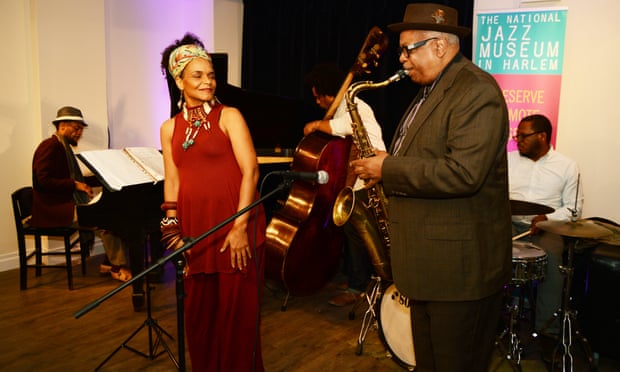Pianist Marc Cary, vocalist Terri Davis, tenor saxophonist Bill Saxton, drummer Russell Carter and bassist Rahsaan Carter perform. Photograph: National Jazz Museum in Harlem
Martin Pengelly
@MartinPengelly
Saturday 2 April 2016 12.00 BST
One of Tim Porter’s first projects as chairman of the board at the newly reopened National Jazz Museum in Harlem, in New York City, will be a series of talks and performances under the title Mies and Miles. The great modernist Mies van der Rohe; the great trumpeter Miles Davis. Porter’s programme will explore the links between architecture and music.
“Daniel Libeskind, the architect of the new World Trade Center tower, said without music we could not have architecture, and without architecture we could not have music,” said Porter, himself a jazz mandolinist of wide repute. “Goethe said architecture was ‘frozen music’.”
In the museum’s new space a permanent exhibit, Vibrations, furthers Porter’s point. It includes an enlargement of part of the score for Harlem Air Shaft by Duke Ellington, a piece which, Porter said, expresses in music sounds heard in – or through – a building in the museum’s own neighbourhood.
“It’s architecture into music,” Porter said, “in the same way that Bud Powell put the sounds of the Champs d’Élysées into A Parisian Thoroughfare.”
He added: “This music which we call jazz owes so much to Harlem, and in Harlem it set off vibrations that went off throughout the world.”
The National Jazz Museum was founded in 1997 by Leonard Garment, who was both counsel to President Nixon and a professional jazz musician. It first operated from a fourth-floor space in East Harlem. After a long and sometimes difficult search for a new home, supervised by the saxophonist, pianist and jazz historian Loren Schoenberg, it has crossed to the other side of the island.
The new premises are on West 129th street, just off Malcolm X Boulevard and “a couple of blocks from Sylvia’s Restaurant”, the hallowed soul food joint where presidents – and would-be presidents – pay court. The museum has become, in Porter’s words, “a lot more visible”, ready to play an active part in a thriving Harlem arts scene.
read more: http://news360.com/digestarticle/-BGfQGLFN0qLib-IRazHJQ


0 Comments:
Post a Comment